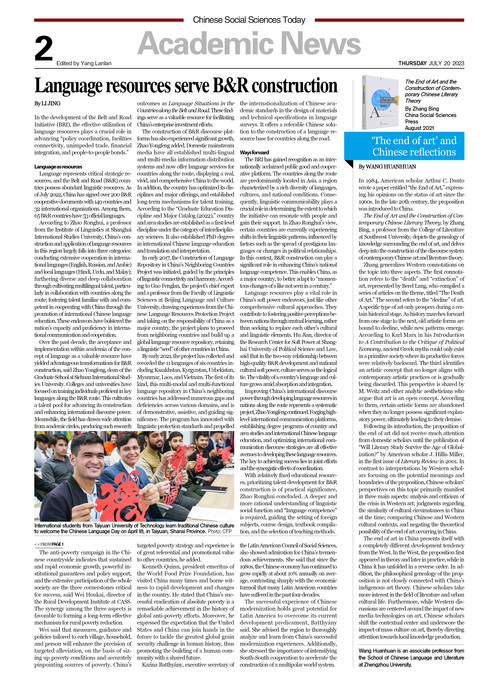Language resources serve B&R construction
2023-07-20 17:44:05
International students from Taiyuan University of Technology learn traditional Chinese culture to welcome the Chinese Language Day on April 18, in Taiyuan, Shanxi Province. Photo: CFP
By LI JING
In the development of the Belt and Road Initiative (BRI), the effective utilization of language resources plays a crucial role in advancing “policy coordination, facilities connectivity, unimpeded trade, financial integration, and people-to-people bonds.”
Language as resources
Language represents critical strategic resources, and the Belt and Road (B&R) countries possess abundant linguistic resources. As of July 2022, China has signed over 200 B&R cooperative documents with 149 countries and 32 international organizations. Among them, 65 B&R countries have 53 official languages.
According to Zhao Ronghui, a professor from the Institute of Linguistics at Shanghai International Studies University, China’s construction and application of language resources in this region largely falls into three categories: conducting extensive cooperation in international languages (English, Russian, and Arabic) and local languages (Hindi, Urdu, and Malay); furthering diverse and deep collaboration through cultivating multilingual talent, particularly in collaboration with countries along the route; fostering talent familiar with and competent in cooperating with China through the promotion of international Chinese language education. These endeavors have bolstered the nation’s capacity and proficiency in international communication and cooperation.
Over the past decade, the acceptance and implementation within academia of the concept of language as a valuable resource have yielded advantageous transformations for B&R construction, said Zhao Yongfeng, dean of the Graduate School at Sichuan International Studies University. Colleges and universities have focused on training individuals proficient in key languages along the B&R route. This cultivates a talent pool for advancing its construction and enhancing international discourse power. Meanwhile, the field has drawn wide attention from academic circles, producing such research outcomes as Language Situations in the Countries along the Belt and Road. These findings serve as a valuable resource for facilitating China’s enterprise investment efforts.
The construction of B&R discourse platforms has also experienced significant growth, Zhao Yongfeng added. Domestic mainstream media have all established multi-lingual and multi-media information distribution systems and now offer language services for countries along the route, displaying a real, vivid, and comprehensive China to the world. In addition, the country has optimized its disciplines and major offerings, and established long-term mechanisms for talent training. According to the “Graduate Education Discipline and Major Catalog (2022),” country and area studies are established as a first-level discipline under the category of interdisciplinary sciences. It also established PhD degrees in international Chinese language education and translation and interpretation.
In early 2017, the Construction of Language Repository in China’s Neighboring Countries Project was initiated, guided by the principles of linguistic connectivity and harmony. According to Guo Fenglan, the project’s chief expert and a professor from the Faculty of Linguistic Sciences at Beijing Language and Culture University, drawing experiences from the Chinese Language Resources Protection Project and taking on the responsibility of China as a major country, the project plans to proceed from neighboring countries and build up a global language resource repository, retaining a linguistic “seed” of other countries in China.
By early 2021, the project has collected and recorded the 11 languages of six countries including Kazakhstan, Kyrgyzstan, Uzbekistan, Myanmar, Laos, and Vietnam. The first of its kind, this multi-modal and multi-functional language repository in China’s neighboring countries has addressed numerous gaps and deficiencies across various domains, and is of demonstrative, assistive, and guiding significance. The program has innovated with linguistic protection standards and propelled the internationalization of Chinese academic standards in the design of materials and technical specifications in language surveys. It offers a referable Chinese solution to the construction of a language resource base for countries along the road.
Ways forward
The BRI has gained recognition as an internationally acclaimed public good and cooperative platform. The countries along the route are predominantly located in Asia, a region characterized by a rich diversity of languages, cultures, and national conditions. Consequently, linguistic communicability plays a crucial role in determining the extent to which the initiative can resonate with people and gain their support. In Zhao Ronghui’s view, certain countries are currently experiencing shifts in their linguistic patterns, influenced by factors such as the spread of prestigious languages or changes in political relationships. In this context, B&R construction can play a significant role in enhancing China’s national language competence. This enables China, as a major country, to better adapt to “momentous changes of a like not seen in a century.”
Language resources play a vital role in China’s soft power endeavors, just like other comprehensive cultural approaches. They contribute to fostering positive perceptions between nations through mutual learning, rather than seeking to replace each other’s cultural and linguistic elements. Hu Jian, director of the Research Center for Soft Power at Shanghai University of Political Science and Law, said that in the two-way relationship between high-quality B&R development and national cultural soft power, culture serves as the logical tie. The vitality of a country’s language and culture grows amid absorption and integration.
Improving China’s international discourse power through developing language resources in nations along the route represents a systematic project, Zhao Yongfeng continued. Forging high-level international communication platforms, establishing degree programs of country and area studies and international Chinese language education, and optimizing international communication discourse strategies are all effective avenues to developing these language resources. The key to achieving success lies in joint efforts and the synergistic effects of coordination.
With relatively fixed educational resources, prioritizing talent development for B&R construction is of practical significance, Zhao Ronghui concluded. A deeper and more rational understanding of linguistic social function and “language competence” is required, guiding the setting of foreign subjects, course design, textbook compilation, and the selection of teaching methods.



